College Sports
David Carle at Home at Denver
Story Links Carle Signs Multi-Year Extension Watch: Carle Stays at Denver David Carle wanted to make something clear: Denver is home for him and his family, and he isn’t planning on leaving his position as the University of Denver Richard […]
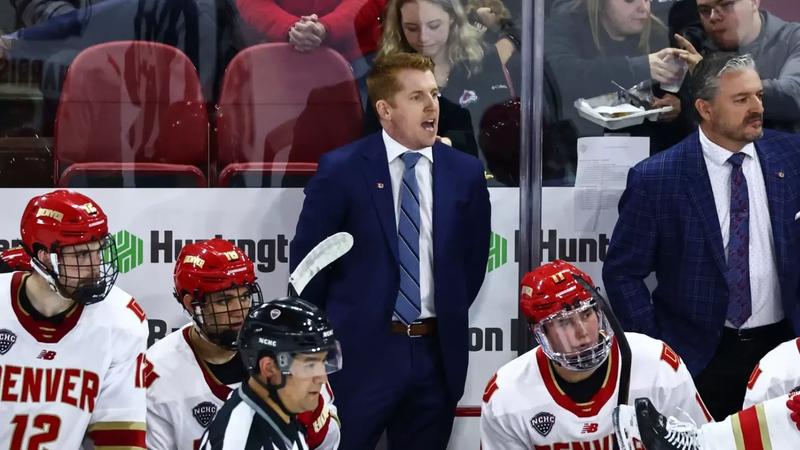
David Carle wanted to make something clear: Denver is home for him and his family, and he isn’t planning on leaving his position as the University of Denver Richard and Kitzia Goodman Hockey Head Coach any time soon.
“At the end of the day, this is I think the best job outside the NHL, potentially a better job, and some guys in the NHL would trade with me if they had that opportunity,” Carle said. “I love working with our players. I love working in this environment.”
Carle is staying with the Pioneers after signing a multi-year contract extension on May 5, keeping him at the helm of a program that might be going through one of its best periods in its 75-year-plus history.
Since taking over as the then-youngest head coach in Division-I college hockey on May 25, 2018, Carle has guided the Pioneers to 179 wins—the third-most among all NCAA bench bosses in that time—two NCHC Penrose Cups as regular-season champions, the 2024 NCHC Frozen Faceoff conference tournament title, four trips to the NCAA Frozen Four and two national championships. He was the fourth-youngest coach to win his first NCAA title in 2022 (32 years, 5 months, 0 days) and is the youngest ever to win two championships following the Pioneers’ record 10th victory in 2024 (34 years, 5 months, 4 days).
After seven years, the now 35-year-old already has a resume that rivals some of the best coaches ever at this level, and that doesn’t include the back-to-back gold medals he won as the head coach with Team USA at the 2024 and 2025 IIHF World Junior Championships.
So it’s not surprising that the Anchorage, Alaska, native has drawn interest from National Hockey League squads in recent years for their own head coach vacancies. Carle has interviewed with clubs previously, but it became even more clear that DU was the place for him after going through the process this spring.
“I think you’re always open minded to things that come your way and wanting to have those conversations, and I think it only helps me learn and grow more,” Carle said of the NHL opportunities. “It only helps our program in many ways.”
The Pioneer bench boss is well-aware of the current lifespan of NHL head coaches, which is approximately two seasons. That played a factor in his decision to stay at the collegiate level.
“There’s no issue in being patient—27-of-32 jobs have turned over in the last three years. Some of those jobs have turned over multiple times, so the number’s even higher than 27,” Carle said. “It’s a reality that I’d be foolish to put my head in the sand and not think that that’s a real thing.”
Carle noted that “Denver is home for me and my family,” and he has spent almost all of the past 17 years living within a mile of the DU campus—the only exception being one and a half seasons when he took his first job out of college as an assistant on the USHL Green Bay Gamblers. He now has three young children and stability at his alma mater, which began when the school honored his scholarship after his playing career was cut short following a diagnosis of hypertrophic cardiomyopathy in 2008.
“We got three kids, we love living in Denver, think it’s a wonderful place to raise our kids,” Carle said. “We live real close to here… I feel very fortunate to continue to stay and to work here and serve here in the role that I’m in.”
The Pioneers program also continues to be invested in at a high level to stay at the forefront of the college hockey landscape. What began with a still state-of-the-art locker room renovation has led to new boards, glass, lighting and seats in Magness Arena to improve the fan experience, enhanced team travel with privately-funded charter flights to select road games, Alston Award benefits for the student-athletes and the addition of a third full-time assistant coach on staff.
“I feel really grateful for the support that they (DU) have done for a number of years but certainly stepping up in different ways… The investment that the school continues to put into our hockey program to ensure that it’s at an elite level is always much appreciated,” Carle noted. “As we got into the season, more conversations occurred (with administration on a new contract), and felt it was all in a great spot. I love being here, and really have no reason to leave.”
Carle has made his own investment into the hockey program as well. He pledged a multi-year gift to support current and new initiatives with the Pioneers and was the first Denver Athletics head coach to join the department’s Gold Standard Society.
His gift will go directly to Murray Armstrong Hockey Student-Athlete Enhancement Fund and the Athletics Excellence Fund, with the former being created in 2020 by David Paderski in honor of the former Pioneers coach that won five national titles and owns 460 victories while at the helm of the program from 1956 to 1977.
“The Carle family commitment, along with the support of our university leadership, students, alumni, donors, season-ticket holders and fans, empowers the program to continue to chase competitive and academic excellence year in and year out,” said Josh Berlo, DU’s Athletic Director and Vice Chancellor.
“There is not a more necessary time that we need that fund to grow,” Carle said. “To honor Murray, there’s no better person to honor in Denver hockey than what he did for us. Then the university and the athletic department, the Gold Standard Society is an opportunity to support all of our student-athletes. That initiative began last year and really proud and honored to be a part of it.”
Those investments aim to help the Pioneers build upon their six Frozen Four appearances and three national championships since 2016.
The program has been on a great run the past decade, but Carle isn’t satisfied with where the team is at. Yes, DU made its 20th Frozen Four in 2024-25, but it came short of its ultimate goal of adding an 11th title to the trophy cabinet.
Winning championships is what drives Carle and his players.
“The standards and the expectations never change,” Carle said. “That’s one of the great parts of working here, and something that obviously we as a program have created long before I got here.”
College Sports
Massapequa High School holds 70th graduation ceremony
Massapequa High School held its graduation ceremony at Hofstra University. Photo by Casey Fahrer Massapequa High School seniors threw their caps in the air as they celebrated the end of their academic careers within the district. Massapequa held its 70th graduation ceremony on Friday, June 20, at Hofstra University’s David S. Mack Sports & Exhibition […]

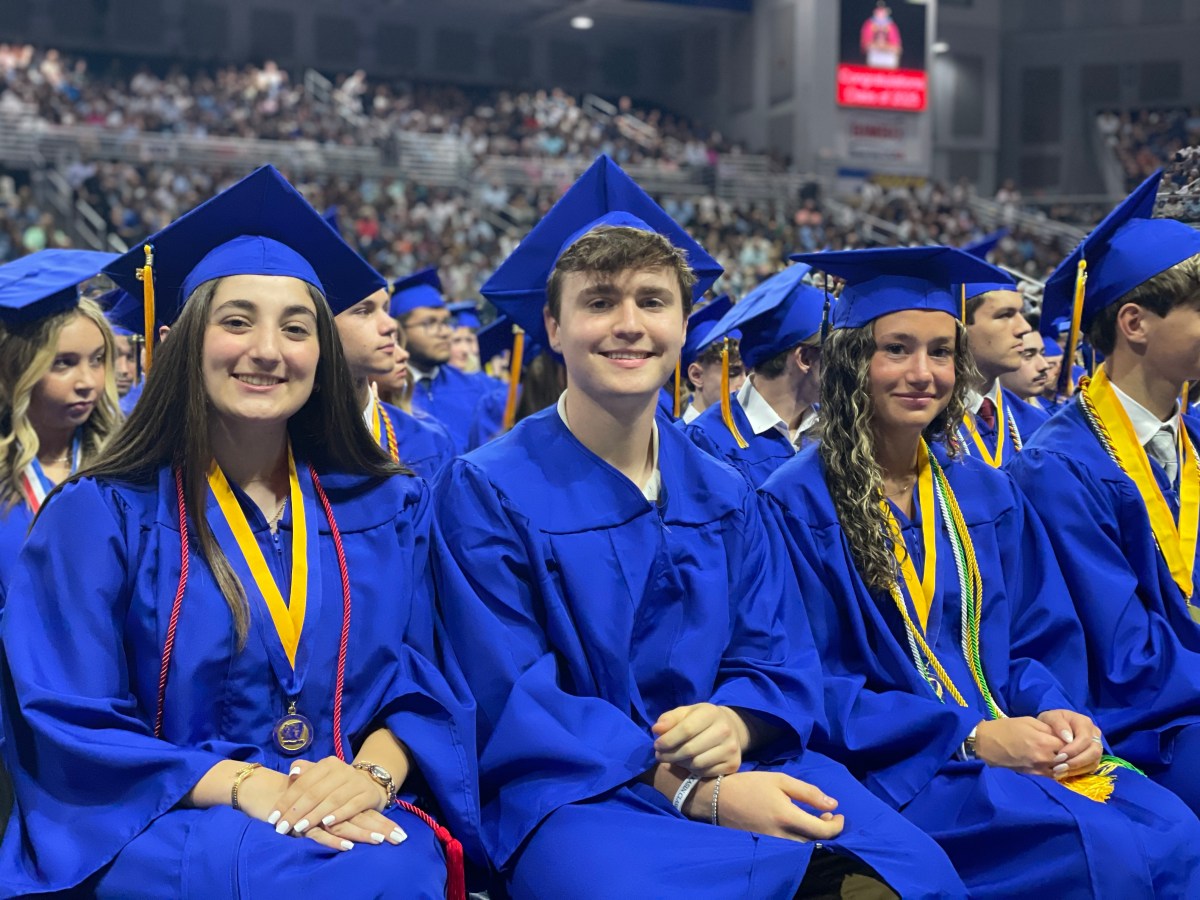
Massapequa High School held its graduation ceremony at Hofstra University.
Photo by Casey Fahrer
Massapequa High School seniors threw their caps in the air as they celebrated the end of their academic careers within the district.
Massapequa held its 70th graduation ceremony on Friday, June 20, at Hofstra University’s David S. Mack Sports & Exhibition Center. Over 450 seniors received their diplomas, something that Superintendent William Brennan called a big accomplishment.
“Today isn’t just a celebration, it’s a milestone,” he said.
Brennan opened up the ceremony by talking about the accomplishment, saying that education isn’t just about tests and grades. Massapequa High School Principal Barbara Lowell said the average GPA of seniors this year was above 90.
Lowell also said the graduating class received over $14 million combined in scholarship money for their future education. She highlighted the difference between the current seniors and the first set of seniors in the district in 1956.
“The world needs your light. It needs your compassion. It needs your creativity. It needs your courage,” Lowell told the 2025 class. “And no matter where life takes you, know that you will always have a home at Massapequa High School.”
Four students, Olivia Valaroso, Jackson Yahner, William Stebner and Samantha Portz, gave commencement speeches as well, all calling for the graduating seniors to show confidence, courage and passion with their future endeavors.
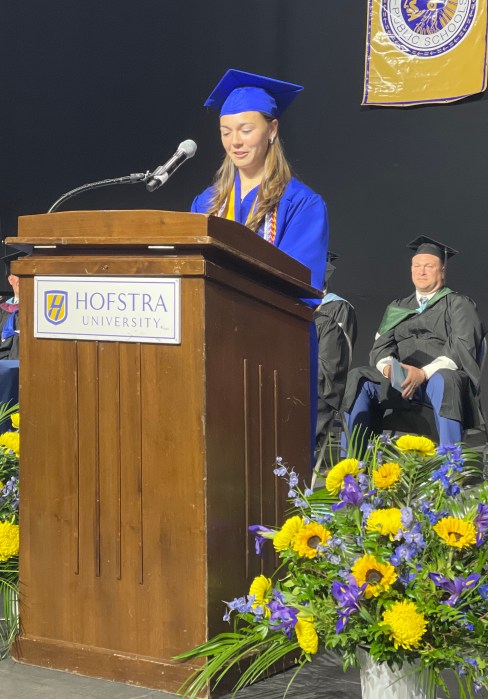
Multiple speakers also remembered Connor Kasin, a Massapequa senior who died while playing for the school’s varsity ice hockey team in November 2024.
Speakers also made sure to recognize the school’s mascot, as multiple people referred to the graduates as “Chiefs.”
“Chiefs lead, Chiefs give back, Chiefs serve,” Portz, the class’ valedictorian, said.
The district has been in a public legal battle with the state as Massapequa fights to keep its Native American name as the Chiefs.

College Sports
How revenue sharing should be distributed across the Big Ten Conference
For the likes of the Michigan Wolverines, the House vs. NCAA settlement was a small blip in the spending the athletic program already participates in every year, and it will be merely a percentage that must be allocated to athletes rather than other expenses. But that’s not the case for the entire country, let alone […]

For the likes of the Michigan Wolverines, the House vs. NCAA settlement was a small blip in the spending the athletic program already participates in every year, and it will be merely a percentage that must be allocated to athletes rather than other expenses.
But that’s not the case for the entire country, let alone the rest of the Big Ten. While Michigan and Ohio State bring in more than $160 million in athletic revenue every year, other Big Ten members such as Maryland, UCLA and Rutgers are much lower on the list, generating $81 million, $82 million and $72 million, respectively.
While these are still big numbers to the untrained eye, the Big Ten has been given direction to give $20.5 million to its athletes as part of direct revenue sharing during the 2025-26 academic year. While this is 10 percent of its revenue for Ohio State, it is 28 percent for Rutgers, according to NIL-NCAA. This could cause a massive disparity in salary caps, funds towards travel, training facilities expenses, staffing and many more costs that some programs just do not have the money for.
:no_upscale()/cdn.vox-cdn.com/uploads/chorus_asset/file/26031384/Screenshot_2025_06_18_at_3.43.11_PM.png)
Under the direction of House vs. NCAA, Division I programs are asked to follow a model that gives 75 percent of the $20.5 million to football (coming out to $15,375,000), 10 percent to men’s basketball ($2,050,000), five percent to women’s basketball ($1,025,000) and five percent to the school’s other varsity sports.
While this is a nice, overarching framework, that may not be practical in the grand scheme of things. If a program like Rutgers wants to be competitive for years to come, other strategies may need to be enlisted regarding the allocation of that money.
How revenue sharing should be distributed across the Big Ten
The Wolverines have 29 varsity sports that Warde Manuel is dedicated to keeping. The Buckeyes have 36, Maryland has 20, Northwestern has 19. As you can see, giving five percent to sports other than football and basketball can vary greatly between schools, and this is where strategy may come into play.
Take UCLA for example, a powerhouse in women’s gymnastics. Or USC, the national leader in beach volleyball. If programs want to compete for both Big Ten championships and national championships, putting money into these smaller programs could be where we see dynasties start forming.
While football has the big, flashy number now, things can change very quickly when programs start getting ahead of the competition.
Say in a year that athletic departments have more flexibility with their allocation of revenue sharing money. With scholarship limits already increased for the upcoming academic year, there is little-to-no oversight on how schools should be spending their money. Sure, if Michigan is spending $146,000 per year on each of their football players, it may be more difficult to compete with that by taking money away from other football programs.
However, realizing there are other ways of competing may be the first domino that needs to fall for schools to pivot and find their lane elsewhere. Here is a list of one sport outside of football and basketball that each Big Ten should prioritize going forward based on recent success (i.e. Big Ten championships and standings):
- Iowa – Wrestling
- Illinois – Men’s and Women’s Golf
- Indiana – Men’s Soccer
- Maryland – Men’s and Women’s Lacrosse
- Michigan – Ice Hockey
- Michigan State – Ice Hockey
- Minnesota – Ice Hockey
- Nebraska – Women’s Volleyball
- Northwestern – Field Hockey
- Ohio State – Women’s Volleyball
- Oregon – Baseball
- Penn State – Ice Hockey
- Purdue – Wrestling
- Rutgers – Rowing
- USC – Beach Volleyball
- UCLA – Women’s Gymnastics
- Washington – Men’s and Women’s Track and Field
- Wisconsin – Women’s Volleyball
This list displays a very unique situation in which school’s of different sizes, athletic program revenue and geographical location could potentially run a particular sport if they allocate the right amount of money to that sport.
When asked questions about other potential revenue pools, Ohio State athletic director Ross Bjork said, “We thought volleyball could be a sport that could drive more revenue.”
Similarly, Penn State athletic director Dr. Patrick Kraft said, “We’re trying to be able to manage the money so that if we need to move on someone, no matter what the sport is, we have the ability to say, ‘Hey, there’s the No. 1 fencer in the world, and we need to go use rev-share to maybe tilt it our way, we’re going to be able to do that.”
From golf to wrestling to lacrosse and every sport in between, we could see Big Ten schools separate themselves from one another, taking home Big Ten championships, the prize money and the publicity that would come with it.
How can the Big Ten leave their mark as a conference, and individually?
Revenue sharing is meant to create many benefits for programs. It increases the scholarships a school can give out, giving programs more flexibility with recruiting and roster spots. It should make athletes happier about their worth, and it gives coaches and staff another resource to use when recruiting and retaining athletes. And, in theory, it evens out the competition, allowing for schools to have the same resources as one another to compete for championships.
However, there are still going to be economic and resource disparities. It is how each school handles these inequalities which will be the true test of sustainability and continuous success.
College Sports
Kenny Dillingham Sparks Excitement in Arizona State Football Revival
A New Era for Arizona State Football In the heart of Tempe, a seismic shift is occurring within the Arizona State football program, one that is reshaping its identity and aspirations. Not long ago, the Sun Devils were synonymous with vibrant campus life and spirited frat parties, overshadowing their athletic endeavors. However, the arrival of […]

A New Era for Arizona State Football
In the heart of Tempe, a seismic shift is occurring within the Arizona State football program, one that is reshaping its identity and aspirations. Not long ago, the Sun Devils were synonymous with vibrant campus life and spirited frat parties, overshadowing their athletic endeavors. However, the arrival of head coach Kenny Dillingham has injected a newfound vigor into the program, signaling a transformative journey that aims to redefine what Arizona State football can achieve.
Kenny Dillingham’s Vision
Kenny Dillingham, donning a headset and fueled by determination, has taken the reins of a program that was struggling to find its footing. His first season, marked by a challenging 3-9 record, served as both a wake-up call and a foundation for future growth. Dillingham’s approach is not merely about winning games; it’s about instilling a culture of resilience and ambition. His vision extends beyond the field, as he seeks to elevate the Sun Devils into a competitive force within college football.
Dillingham’s leadership embodies a blend of strategic ingenuity and motivational prowess, inspiring players to embrace a winning mentality. He has made it clear that mediocrity is no longer acceptable; the goal is to cultivate a program that not only competes but thrives at the highest levels.
Cam Skattebo and the NIL Revolution
Integral to Dillingham’s vision is the emergence of players like Cam Skattebo, who is leading the charge in the evolving landscape of Name, Image, and Likeness (NIL) opportunities. Skattebo’s influence goes beyond the gridiron; he represents a new generation of athletes who are capitalizing on their marketability while enhancing the program’s reputation. His proactive engagement in the NIL space is shattering misconceptions about Arizona State, illustrating that the Sun Devils are not just a party school but a burgeoning powerhouse in collegiate athletics.
The NIL revolution has become a game-changer, providing athletes with unprecedented opportunities to monetize their talents. For Arizona State, this means attracting top-tier talent and fostering an environment where players can thrive both on and off the field. Skattebo’s initiatives highlight the potential for the Sun Devils to not only compete in games but also in the broader narrative of college sports.
The Arrival of Sam Leavitt
Adding to the excitement surrounding Arizona State football is the anticipated arrival of quarterback Sam Leavitt. His decision to join the Sun Devils is a testament to the program’s revitalization under Dillingham’s guidance. Leavitt’s skill set and competitive spirit align perfectly with the vision Dillingham has for the team, promising to elevate the offensive capabilities and bring a fresh dynamic to the roster.
Leavitt’s commitment signifies more than just a new player; it represents a collective belief in the direction Arizona State is headed. As the program continues to attract talent, the potential for significant achievements in the coming seasons becomes increasingly tangible.
Looking Ahead
As Kenny Dillingham charts a new course for Arizona State football, the combination of strategic leadership, innovative athlete engagement through NIL, and the influx of promising talent like Cam Skattebo and Sam Leavitt is setting the stage for an exciting future. The Sun Devils are no longer defined by their past; instead, they are embracing a bold new identity that seeks to challenge the status quo in college football.
In this transformative era, Arizona State is poised to emerge as a formidable contender, not just in the Pac-12 but on a national scale. The journey ahead may be fraught with challenges, but with a clear vision and a commitment to excellence, the Sun Devils are ready to redefine their legacy. This is not just about football; it’s about building a program that resonates with ambition, integrity, and a relentless pursuit of greatness.
College Sports
Heat Checks & Hail Marys – The Illini Football Return to Greatness Movie & How NIL Has (and Could’ve) Changed the NBA Draft
Mike Cagley, Co-Host Sports Spectacular June 23, 2025 This was a slower week for college sports overall as now most of the work is being done behind the scenes to define the House settlement and try to calm the chaos around college sports. It wasn’t a slow time for Bret Bielema and the Fighting Illini […]
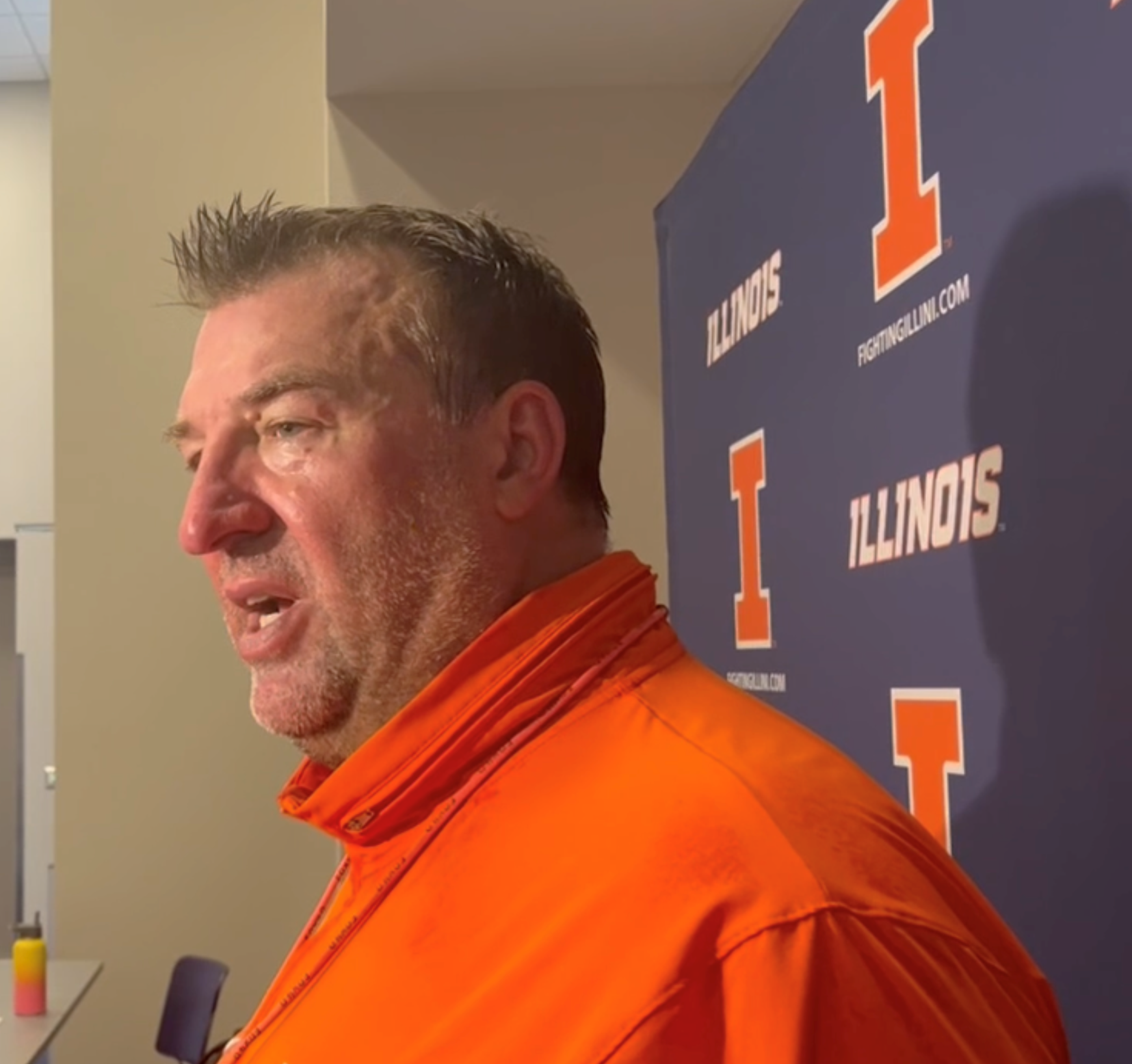
Mike Cagley, Co-Host Sports Spectacular
June 23, 2025
This was a slower week for college sports overall as now most of the work is being done behind the scenes to define the House settlement and try to calm the chaos around college sports.
It wasn’t a slow time for Bret Bielema and the Fighting Illini football program who earned commitments from Kayden Bennett, Kai Prichard, Isaiah Williams, and Nick Hankins. All are at least 3-star recruits, and most are 4-star recruits depending upon the ratings service you follow.
Bielema is on a recruiting hot streak that might have been equaled by Ron Zook and there’s a chance Bielema’s streak might possibly be the hottest an Illini football coach has been in…forever.
Hail Mary #1 – If the Illini Football Program’s Return to Greatness was a Movie…
The Illini football program is poised to return to greatness under Bret Bielema. It’s fair to say one can debate if the Illini football program has ever hit “greatness” in the first place. No matter the answer to the “greatness” question, certainly Bielema is the first accomplished college football coach on the Illini sidelines since John Mackovic put on the headset for Illinois.
If one were to make a movie of this season, of Bielema taking the Illini football program to the College Football Playoff, most would consider a CFP berth to be an obstacle that most fans would believe to be unthinkable. Why would they think that? Because it’s a goal that is so darn hard that the Illini haven’t ever approached achieving it.
To have a great movie, novel or story, you must have a great villain. The Illini have quite a few obstacles to overcome. When combined, these obstacles block the path to success in a way as threatening and intimidating as a Thanos-level villain would. Let’s take a look at the obstacles faced by the Illini:
- The Illini football program has never been great – it may have had fantastic players like Red Grange, Dick Butkus and David Williams – but the football program has never experienced sustained success.
- The football program has only had two solid coaches since 1980 – just Mike White and John Mackovic. The rest have created a massive hole for Bielema to lift the program out of. Thank goodness Josh Whitman chose Bret Bielema to head the Illini football program.
- The B1G is a top-heavy conference with sharks like Ohio State, Michigan, Penn State, Oregon and USC at the top trying to eat any competition that rises from the depths.
- The University of Illinois resides in a small town without the metro areas that Ohio State, USC and Michigan can rely upon for their NIL fundraising efforts.
In the movie world, obstacles like this don’t prevent the story from having a negative conclusion if there is a hero to overcome them. In fact, obstacles like these make the success at the end of the film ultimately creates the hero that the public wants.
Thus, the film also needs a hero. Bielema has ridden into town and single-handedly cleaned up the lawless city. Clint Eastwood couldn’t have done a better job.
Bielema has the Illini on the verge of a potentially historic season for Illinois. No one is guaranteeing the Illini will have their second 10-win season back-to-back. Even if the Illini make a bowl for the second season in a row or were to fall short of that mark, they are recruiting the building blocks of future success with each recruit that commits. The bottom line is that there’s a reason for hope in the future while enjoying this season’s success. The Fighting Illini are relevant again.
If there was a movie depicting this Illini football season, Illinois has two paths the plot might take:
- Fall short of making a bowl and continue the up-and-down nature of Illini football.
- Win enough to go to a bowl again and maybe even find a way to make the College Football Playoff.
Bielema has decided to follow the path of surrounding himself with successful coaches and players. He didn’t wait for the perfect day to arrive to begin his mission. He began this journey the day he started as the head football coach of the Fighting Illini, back when no one thought last season’s success was remotely possible.
This season is the time for no excuses and by overcoming the obstacles listed above, this year will make for an epic adventure. Coupled with these recruiting successes, it will be the first step of a mythic quest, not just one “high flying” season standing in the midst of ongoing mediocrity.
I think the 2025 Illini football season would make a great movie. The obstacles are there. So is the hero. The team is ready. In a Marvel movie, the heroes would yell, “Avengers, Assemble!” Later this summer, the Thing (of the Fantastic Four) will yell out, “It’s clobberin’ time!”
Lights! Camera! Action!
Heat Check #1 – NIL Could’ve (and Should’ve) Changed the NBA Draft in the Illini’s Favor – An Illini “What If”
We are seeing a reversal in the way the NBA Draft is looked at by collegiate basketball players and their agents. Yes, the “and their agents” part seems crazy to me, but who am I to fight the inevitable march of time and constant change?
There were 363 players who entered their names into the NBA draft early in 2021. This summer, just 106 players have entered the 2025 NBA Draft early. This is the lowest since 2016.
As we have talked on the “IlliniGuys Sports Spectacular” radio show and the “I on the Illini” podcasts, the ability to make money has not only made college more attractive to players, but their agents realize this is the way for many college players who aren’t a “lock” to be NBA players to maximize their earnings. Nowadays, there is no reason to risk a big NIL payday for a G League deal that starts around $40,000 a year or an NBA two-way contract that could make them around $600,000.
How times have changed. The NIL dollars can be substantial with deals that dwarf the $600,000 best case option for players on the edge. This means we will see college teams become deeper (if they can afford it) and become older (if they can afford it). Overall, the college game will get better, teams will be more experienced, and the quality of ball will improve.
Not everything is bad about the NIL world.
The biggest “what if” is what if Kofi Cockburn had been surrounded by competent advisors when his time to choose between the NBA Draft and staying at Illinois with a superior NIL deal in place for him.
Kofi improved each year by 3 – 4 points per game and a rebound a game. If he had taken advantage of the two additional years he could’ve played, Kofi might have averaged 24 points and 11 games his senior year and 27 and 12 his COVID year. He might’ve been the NCAA all-time leader in rebounds – and who knows how good the Illini might’ve been. While he wasn’t an NBA player, Kofi was an incredible collegiate player.
The NBA Draft has been changed forever by the effects of NIL. Illini fans just wish Kofi’s advisors had been smart enough to see what most Illini fans that the NIL deal was the better deal.
College Sports
A short guide to Bruin draft possibilities
If the Bruins had won either of the top two slots in the lottery, we’d be able to narrow down their choice pretty easily. The top two picks are locked in, at least according to most draftniks and mock drafters. Defenseman Matthew Schaefer and center Michael Misa are slated to go 1-2. But after that, […]

If the Bruins had won either of the top two slots in the lottery, we’d be able to narrow down their choice pretty easily. The top two picks are locked in, at least according to most draftniks and mock drafters. Defenseman Matthew Schaefer and center Michael Misa are slated to go 1-2.
But after that, it’s a free-for-all. Opinions differ wildly about where certain players will go between No. 3 and No. 10. The B’s, who got bumped down two slots from their fifth-worst finish to have the No. 7 overall pick, should get a decent prospect in that spot (unless they trade out of it, of course). History, however, says that there will be a lemon or two in the top 10. Given their situation, it is imperative the B’s avoid them.
Here are eight players whom the B’s could draft on Friday night. Given the organizational need to draft and develop on a No. 1 centerman, we’ve listed the pivots first. Other than that, there is no order:
* Brady Martin, C, Soo Greyhounds , OHL – There was a day when the Bruins’ lineup was dominated by good ol’ Canadian farm boys. Not so much anymore. After Brad Marchand left, Morgan Geekie, Parker Wotherspoon and newly acquired Fraser Minten were the only players from Canada on the roster down the stretch. Not that great players aren’t being produced all around the world, including right in our own backyard, but Martin would be a throw-back Bruin-type. Raised on an Ontario dairy farm, Martin is now a strapping 6-foot, 186-pound right shot centerman. He was played in all situations for the Greyhounds, notching 33-39-72 totals in 57 games. Martin is a tough, hard-hitting player player who plays a well-rounded game. At the scouting combine, Martin confirmed that the B’s took him out to dinner that week, so the team is at least intrigued by the player.
* Jake O’Brien, C, Brantford Bulldogs, OHL – The 6-foot-2, 177-pound right-shot O’Brien has some David Krejci-like characteristics. He’s a cerebral, pass-first pivot who has the ability to slow the game down, ripping up the OHL for 32-66-98 totals in 66 games. He has high-end vision and hockey IQ. A little lanky, O’Brien could use some strengthening, especially in his lower body, that would improve his skating. Overall, his spindly frame needs some filling out to help in battles, even though he’s shown a willingness to stick his nose into those. And, if he’s going to be a centerman, he needs to improve on faceoffs after finishing below 45%.
* Caleb Desnoyers, C, Moncton Wildcats, QMJHL – The 6-foot-2, 178 pound left-shot pivot led Moncton to the Q championship before the Wildcats fell to the London Knights in the Memorial Cup. He topped Moncton with 35-49-84 totals in 56 games. Pretty good totals for a player who’d been dealing with two injured wrists since November. While some have given him the rather backhanded compliment of being the “safe” pick, one scout said recently, “He’s the guy you want on the ice in the last minute taking the defensive zone draw and protecting a one-goal lead. He’s a winner.” Some mock drafts have him going higher than where the B’s are picking at No. 7, some have him going below. If he’s there at 7, the B’s should pounce.
* James Hagens, C, Boston College – Hagens began last season ranked as the No. 1 prospect in the world. Unlike Macklin Celebrini, who went first overall last June, he wasn’t a freshman phenom. He was just merely very, very good for the Eagles, starting on BC’s top line as a 17-year-old. He tumbled a little bit, as Matthew Schaefer and Michael Misa overtook him. But he will be a top-10 pick, it’s just a matter of where he goes. Centering first-rounders Ryan Leonard and Gabriel Perrault, he had 11-26-37 totals in 37 games for the Eagles. Those numbers suggest a pass-first mentality but, if you’re playing with those two players, it makes sense to get them the puck. At 5-foot-11, 177-pounds, inside ice is not the easiest to access for him but he’s got an impressive skill level.
* Anton Frondell, C, Djurarden, Swe-2 – Some have Frondell going in the top three, others are not so enamored of the solid 6-foot, 196-pound left-shot pivot. He’s had some inconsistency to his game, both in club and international play. While there’s a question as to how big of an impact Frondell will have, there seems to be little doubt that he’s an NHL player. But is he a lead dog or a middle-six center? Unlike some centers in this batch, he’s of the shoot-first variety who can beat the goalie from distance. He’s one of the heavier-playing centers but concerns about his fitness level were calmed by a strong scouting combine earlier this month.
* Roger McQueen, C, Brandon Wheat Kings, WHL – The 6-foot-5, 197-pound right-shot pivot has perhaps the greatest upside of anyone in the draft, but he also carries the biggest red flag. He missed most of the past season in Brandon with back problems. When he played, he was good, recording 10-10-20 in 17 games, but he just didn’t play enough. The B’s wouldn’t exactly be going off the board with McQueen – most mock drafts having him going in the top dozen – but it would take a pretty good gamble from GM Don Sweeney. They also drafted a similarly-framed center last season with Dean Letourneau, who struggled to produce from a fourth line spot at BC.
* Porter Martone, RW, Brampton, OHL – One of the non-centers on this list of possibilities, Martone is the kind of power forward over which many Bruins fans salivate. He’s 6-foot-3 and 208 pounds and, as that size suggests, he’s not that fleet of foot, but he brings a physicality. But he’s also got high-end skill and playmaking abilities, potting 37 goals and 98 points in 57 games. That combo of size and skill may trigger a team to take him before No. 7, but it will be interesting if he’s still around when the B’s are picking.
* Victor Eklund, LW, Djurgarden, Swe-2 – The B’s may have their quota of small and skilled Swedish wingers filled with Fabian Lysell, but the 5-foot-11, 165-pound Eklund is billed as a player who punches above his weight class. He’s a high-energy, ultra-competitive player who has the potential to drive a line from the wing. As a teammate of Frondell’s, Eklund had 19-12-31 totals in 42 games for Djurgarden. While the heart has not been questioned, there is no getting around the size disadvantage. He will need to get stronger. But the burst and creativity he has could be enticing.
College Sports
Journey of uncertainty in transfer portal ends well for Anthony Wayne grad Knapp
MENU ACCOUNT SECTIONS OTHER CLASSIFIEDS CONTACT US / FAQ Link 0
-

 High School Sports3 weeks ago
High School Sports3 weeks agoParents Speak Out As Trans Pitcher Throws Shutout In MN State Quarterfinals
-

 Professional Sports3 weeks ago
Professional Sports3 weeks ago'I asked Anderson privately'… UFC legend retells secret sparring session between Jon Jones …
-

 Health3 weeks ago
Health3 weeks agoOregon track star wages legal battle against trans athlete policy after medal ceremony protest
-

 Professional Sports3 weeks ago
Professional Sports3 weeks agoUFC 316 star storms out of Media Day when asked about bitter feud with Rampage Jackson
-

 Motorsports1 week ago
Motorsports1 week agoNASCAR Weekend Preview: Autódromo Hermanos Rodríguez
-

 NIL2 weeks ago
NIL2 weeks agoPatrick Mahomes in OKC for WCWS, praises NiJaree Canady and Texas Tech
-

 NIL2 weeks ago
NIL2 weeks agoGreg Sankey fires jab at obstruction rule after controversial WCWS call in Texas vs. Texas Tech
-

 College Sports3 weeks ago
College Sports3 weeks agoFull 2025 Women’s College World Series Finals Schedule
-

 NIL3 weeks ago
NIL3 weeks agoReport
-

 NIL3 weeks ago
NIL3 weeks agoTexas Tech Pitcher’s $1M Deal Proves What’s Possible For Women


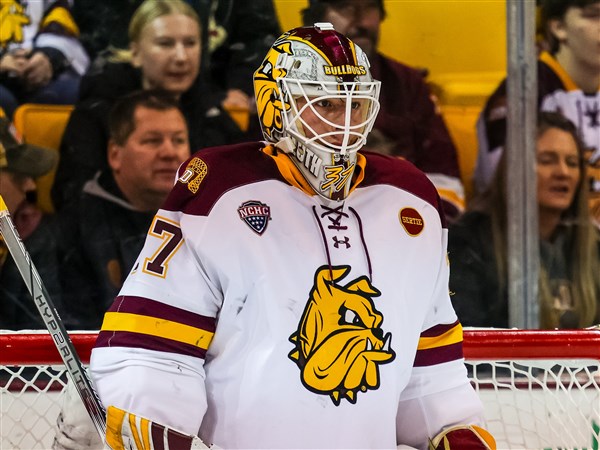

 (via silentpyrotechnics/IG)
(via silentpyrotechnics/IG)


























